The Witch Head Nebula is a very faint reflection nebula located approximately 900 light-years away in the constellation Eridanus. The nebula is illuminated by the bright supergiant star Rigel in Orion. It was nicknamed the Witch Head Nebula because the shape of its dust clouds bears a striking resemblance to a fairy tale witch in profile. The outline of the witch’s face is facing Rigel. The nebula has an apparent magnitude of 13 and is invisible to the unaided eye.
The celestial Witch Head is part of the larger Orion molecular cloud complex, one of the nearest vast star-forming regions to the Sun. The nebula is commonly referred to by its Index Catalogue designation, IC 2118. It is sometimes also known by the New General Catalogue designation NGC 1909.
Reflection nebulae are interstellar dust clouds that reflect the light of one or more stars in the vicinity. If the stars responsible for illuminating the dust clouds are hot enough, they ionize the gas, creating emission nebulae. This is not the case with IC 2118, which merely reflects Rigel’s light.
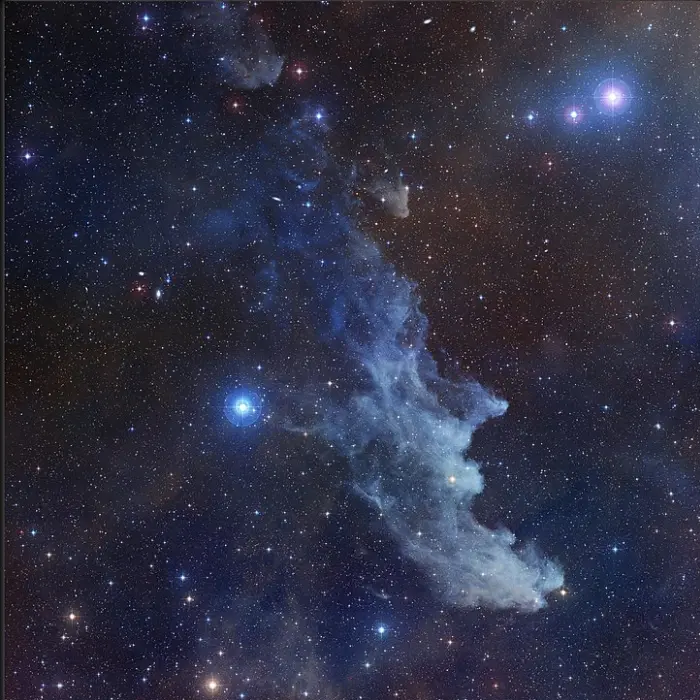
As the name implies, this reflection nebula associated with the star Rigel looks suspiciously like a fairytale crone. Formally known as IC 2118 in the constellation Orion, the Witch Head Nebula glows primarily by light reflected from the star. The color of this very blue nebula is caused not only by blue color of its star, but also because the dust grains reflect blue light more efficiently than red. A similar physical process causes Earth’s daytime sky to appear blue. Image credit: NASA/STScI Digitized Sky Survey/Noel Carboni
Reflection nebulae have similar frequency spectra to those of the stars that illuminate them. The blue colour of the Witch Head Nebula comes from Rigel’s blue colour. It is also caused by the dust grains in the nebula reflecting blue colour more efficiently than red. A similar process is responsible for making our sky appear blue.
The Witch Head Nebula stretches about 70 light-years across. The long filamentary nebula is believed to be an ancient supernova remnant, a gas cloud that formed when a massive star reached the end of its life and went out as supernova. Now, the cloud of cosmic dust reflects the intense light of Rigel (Beta Orionis), the brightest star in the neighbouring constellation Orion.
The nebula itself appears near the third-magnitude giant star Cursa (Beta Eridani), the second brightest star in Eridanus (after Achernar). Cursa lies only 90 light-years away and is not associated with the nebula. The Witch Head lies at a similar distance to Rigel.
Rigel lies 863 light-years away. It is a hot blue supergiant of the spectral type B8 Ia. With a mass 21 times that of the Sun, it will almost certainly end its life as a supernova, much like the progenitor of the Witch Head Nebula.
Rigel has a luminosity 120,000 times that of the Sun and an absolute magnitude of -7.84. It is one of the most luminous stars visible to the unaided eye, with a sufficient energy output to illuminate a nebula that lies at a considerable distance. The supergiant and the nebula are at least 40 light-years apart.
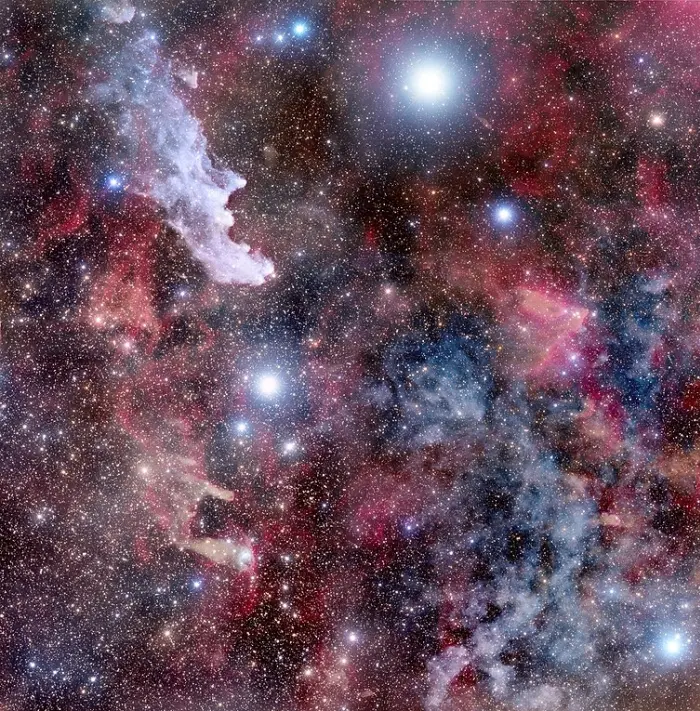
The Witch Head Nebula, image credit: Adam Block (CC BY-SA 4.0)
Radio observations of the Witch Head Nebula have revealed that parts of IC 2118 show significant carbon monoxide emission. This indicates the presence of molecular clouds, where star forming activity occurs, in the region of the nebula.
Astronomers have detected candidate pre-main sequence stars, very young stars that are just beginning their lives, embedded deep within the nebula. These include T Tauri stars, pre-main sequence stars with a mass comparable to that of the Sun. The Sun itself was a T Tauri star before it contracted to the main sequence.
These young stars are more luminous than main sequence stars with the same mass because they have larger radii. They have still not fully contracted to the main sequence and are typically found near molecular clouds. Most of them are part of binary systems.
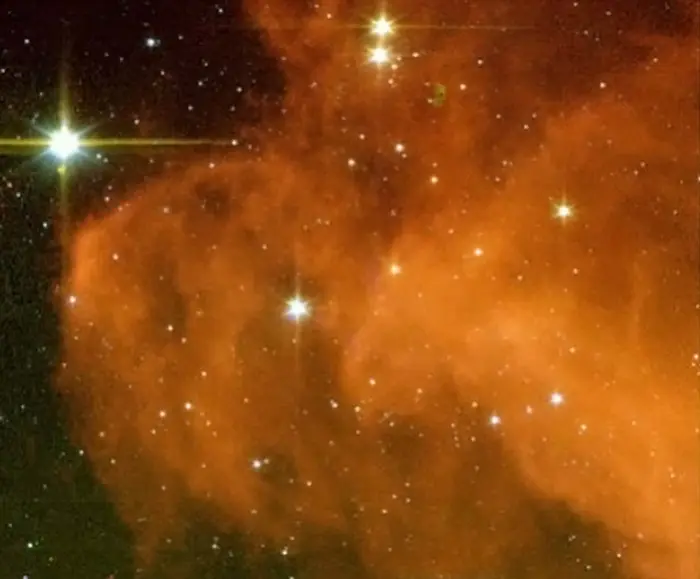
The Witch Head Nebula is teeming with dust-obscured newborn stars waiting to be uncovered. In this image, the super sensitive infrared eyes of NASA’s Spitzer Space Telescope reveal 12 new baby stars in a small portion of the cloud commonly referred to as the Witch Head’s “pointy chin.” The image is a four-color composite where blue represents 3.6 microns, green depicts 4.5 microns, yellow is 5.8 microns, and red is 8.0 microns, image credit: NASA/JPL-Caltech/L. Rebull (SSC/Caltech)
The molecular clouds in the region of the Witch Head Nebula are believed to be associated with the massive stars belonging to the Orion OB1 association. They are juxtaposed to the outer region of the Orion-Eridanus Superbubble. The nebula’s relationship with the Orion OB1 association is supported by the fact that the heads of the nebula’s cometary clouds point northeast, in the direction of the association.
The clouds associated with the Witch Head lie on the surface of the Orion-Eridanus Bubble, a vast supershell carved by multiple supernova events. The clouds have been carved by the strong stellar winds of hot young stars and by the supernovae of the massive blue stars in the Orion OB1 association in the last 10 million years.
Formed from overlapping supernova remnants, the Orion-Eridanus Superbubble is about 1,200 light-years across, and the shock fronts are around 500 light-years apart. The superbubble likely triggered the formation of the young stars in the region of IC 2118.
The young stars formed in the low-mass, high-altitude molecular clouds and have masses in the range from 0.4 to 0.9 solar masses. Their estimated age is 1-4 million years.
A 2001 study identified six molecular clouds in the region of IC 2118, that are probably interacting with the Orion-Eridanus Bubble. Astronomers also detected 46 candidate pre-main sequence stars, seven of which were confirmed to be T Tauri stars.
A 2004 study identified young pre-main sequence stars in the region of the molecular clouds associated with the Witch Head Nebula. The scientists carried out observations with the FLAIR spectrograph installed on the UK Schmidt Telescope and with ALFOSC on Nordic Optical Telescope. They identified five T Tauri stars that appeared to be physically associated with the clouds. The study was published in the journal Astronomy and Astrophysics in April 2004.
Astronomers observed the nebula with the Spitzer Space Telescope and the U. S. Naval Observatory 40-inch telescope in 2010. The infrared observations found the six previously known T Tauri stars in the region, as well as six candidate young stellar objects that had not been previously detected.
These objects were all found in the “head” of the nebula, where the most massive of the several molecular clouds lies. One of these young stellar objects may have an orbiting disk of dust and gas in which planets may be in the process of forming.
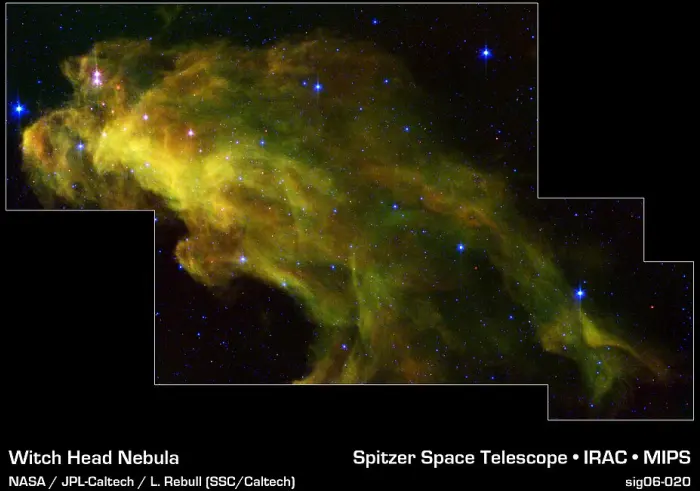
The stellar infants of the Witch Head Nebula are revealed as pink dots in this image from NASA’s Spitzer Space Telescope. Wisps of green in the cloud are carbon-rich molecules called polycyclic aromatic hydrocarbons, which are found on barbecue grills and in automobile exhaust on Earth. This image was obtained as part of the Spitzer Space Telescope Research Program for Teachers and Students, involving high school teachers and their students from across the United States. The infrared image is a three-color composite, in which light with a wavelength of 4.5 microns is blue, 8.0-micron light is green, and 24-micron light is red. Image credit: NASA/JPL-Caltech/L.Rebull (SSC/Caltech)
Facts
The Witch Head Nebula is probably the same object as NGC 1909, discovered by the German-born British astronomer William Herschel on December 20, 1786. Herschel noted “strongly suspected nebulosity of very great extent,” adding that the object extended at least 2°11’ to the north and south and 26’ east and west.
The association between NGC 1909 and IC 2118 is uncertain because Herschel placed the object a little over 11 minutes east of Rigel, when the Witch Head is a little over 11 west of the supergiant star. Precession would have taken Herschel’s object to RA 05 25 53.7, Dec -08 07 41, but there aren’t any objects at those coordinates that match his description, while the Witch Head Nebula does. Herschel may have accidentally reversed the nebula’s position relative to Rigel.
However, since the association between the two objects is relatively recent – NGC 1909 was previously considered a lost object – the Witch Head Nebula is commonly identified by its Index Catalogue designation IC 2118.
The Witch Head Nebula was discovered photographically by the German astronomer Max Wolf on January 16, 1891. Wolf announced his discovery in the Monthly Notices of the Royal Astronomical Society, Vol. 65, in March 1905. He wrote, “The first traces of this nebula were found on a plate taken on 1891 January 16 with a 4-inch Millet portrait lens and with 1h exposure. It appears on many plates, including those of 1894 November 24… There is no doubt that it is attached to the Orion nebulae, all plates showing numerous traces of connexion (sic). The nebula is composed of several streams of nebulosity, and has the appearance of foggy clouds driven by a fresh breeze.”
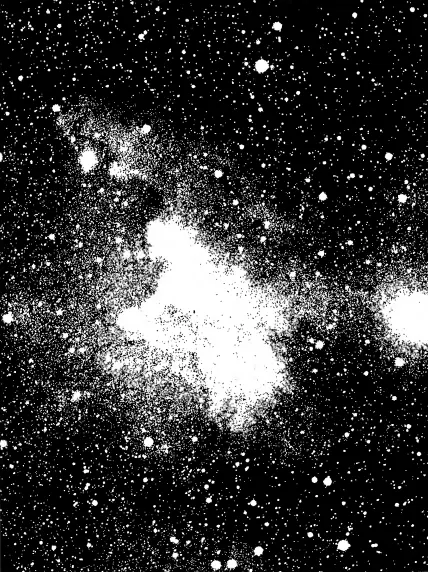
The Witch Head Nebula on a photographic plate, published in the Monthly Notices of the Royal Astronomical Society in March 1905
Danish astronomer John Louis Emil Dreyer, who compiled the New General Catalogue based on William Herschel’s Catalogue of Nebulae, and the supplementary Index Catalogues, described the nebula as extremely large, extending about 2 degrees to the north and south.
The Witch Head Nebula was memorably used in the television series Andromeda (2000) as the site of a major space battle that sent civilization into an era of chaos.
Location
The Witch Head Nebula appears about 2.5 degrees northwest of Rigel, the seventh brightest star in the sky. It lies in the same field as Cursa (Beta Eridani), at the northern end of the celestial River (Eridanus), between the fainter Lambda and Psi Eridani.
Rigel is part of the bright, hourglass-shaped constellation figure of Orion (the Hunter). It is the bottom right star in the crooked hourglass asterism also formed by Betelgeuse, Bellatrix, Saiph, and the three stars of Orion’s Belt, Alnitak, Alnilam, and Mintaka. The brightest stars of Orion are easily visible even from light-polluted areas.
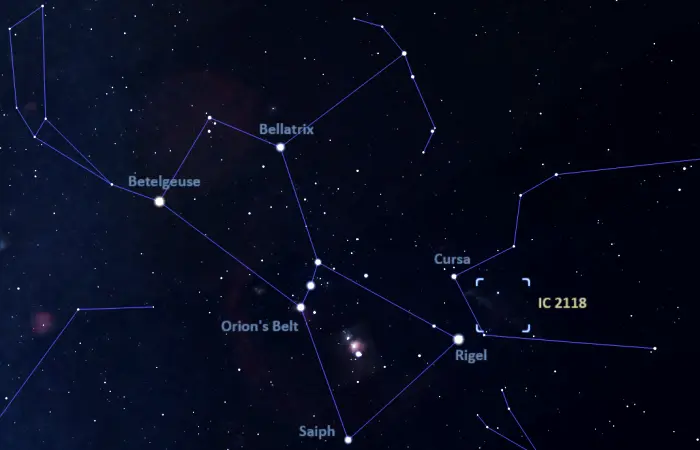
The location of the Witch Head Nebula in Eridanus, image: Stellarium
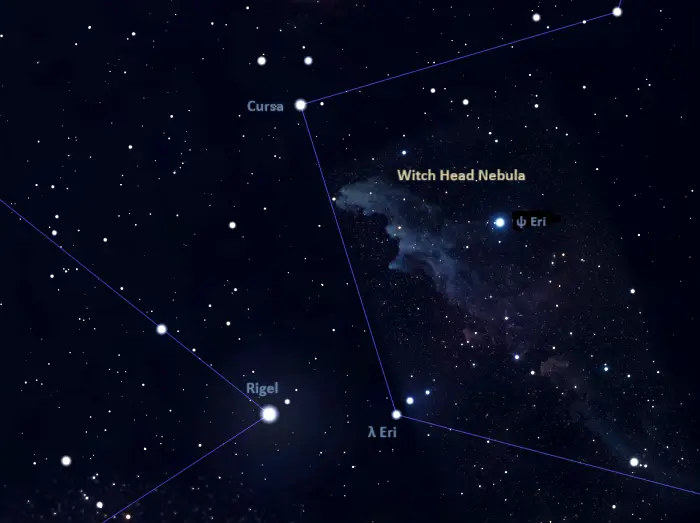
Witch Head Nebula location, image: Stellarium
Even though it is a large object, the Witch Head Nebula is very faint, and it is best observed in large telescopes. At declination -07° 54’, it is visible from virtually anywhere on Earth for at least part of the year.
The best time of the year to observe the stars and deep sky objects in Eridanus and Orion is during the months of December and January, when the constellations are high above the horizon in the evening.
Witch Head Nebula – IC 2118
| Constellation | Eridanus |
| Right ascension | 05h 02m 00.0s |
| Declination | −07° 54′ 00″ |
| Apparent magnitude | 13 |
| Apparent size | 3 × 1° |
| Distance | 900 light-years (276 parsecs) |
| Names and designations | Witch Head Nebula, IC 2118, NGC 1909, Cederblad 41, LBN 959, LBN 207.50-27.78, Hubble I 9, DG 52 |
Images
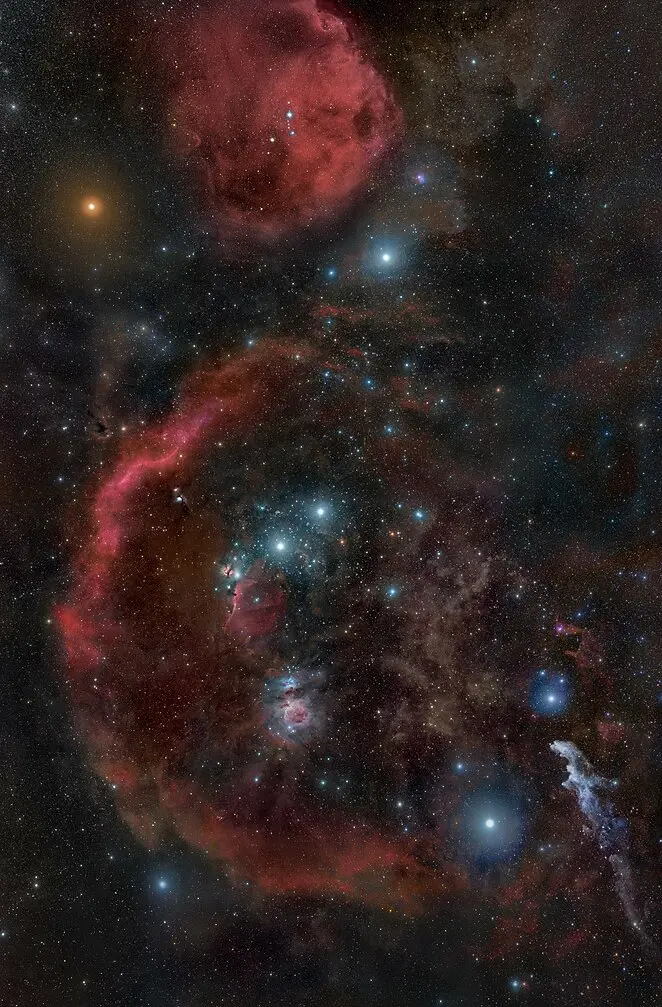
The Witch Head Nebula (bottom right) and Orion, image credit: Rogelio Bernal Andreo (CC BY-SA 3.0)
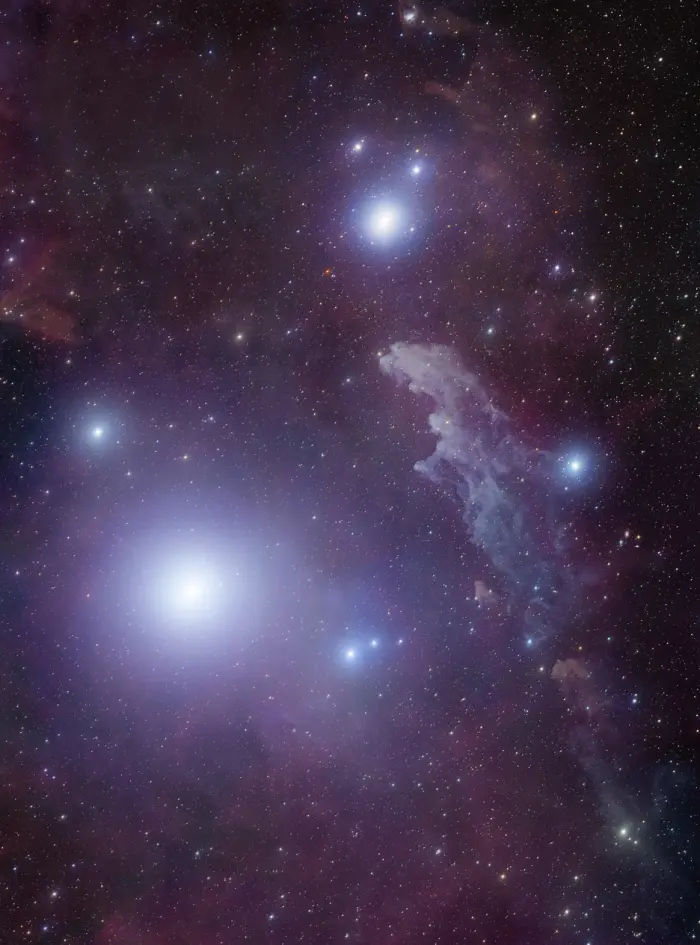
The supergiant Rigel and IC 2118 in Eridanus, image credit: ESO/Robert Gendler (CC BY 4.0)
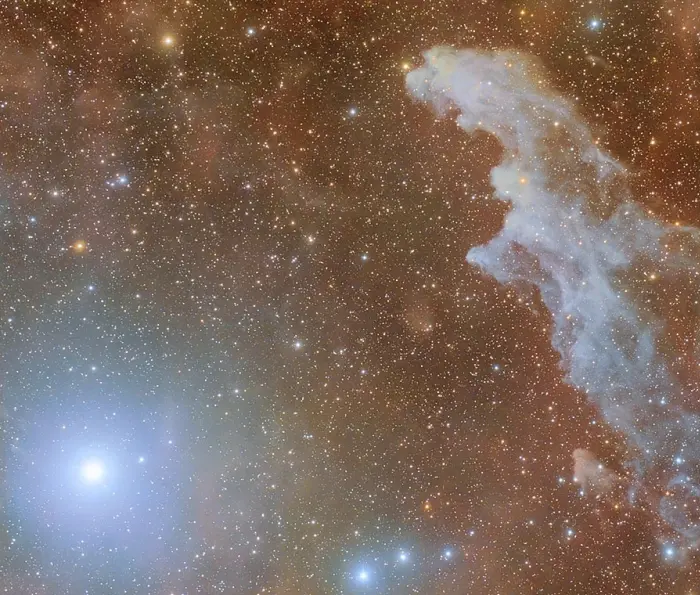
Rigel and the Witch Head Nebula, image credit: Giuseppe Donatiello (CC0 1.0)
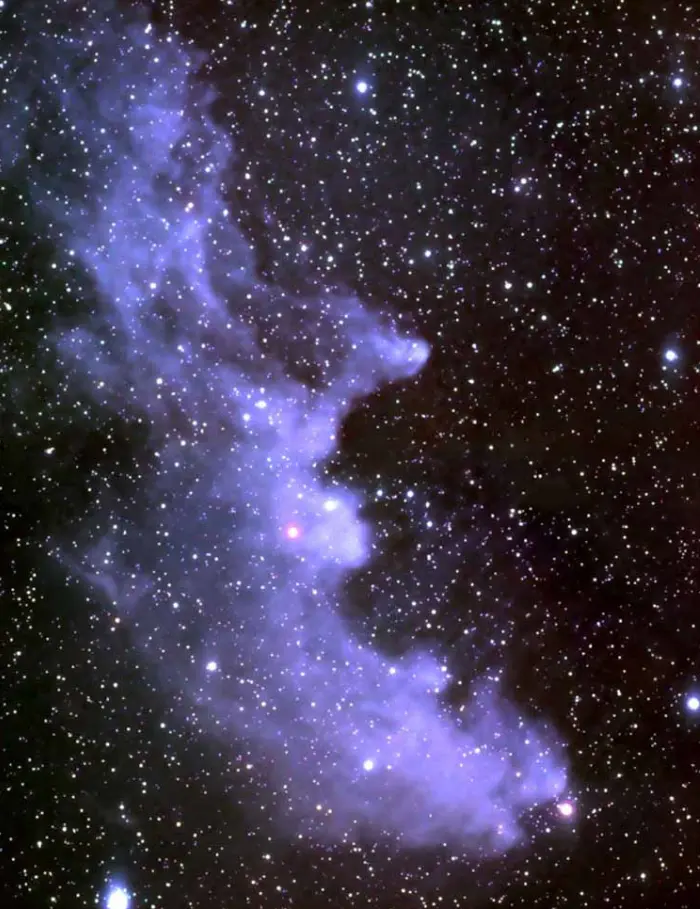
This reflection nebula is associated with the bright star Rigel in the constellation Orion. Known as IC 2118, the Witch Head Nebula glows primarily by light reflected from Rigel, located just outside the top right corner of the image. Fine dust in the nebula reflects the light. Image credit: NASA/Gary Stevens, picture prepared by Adrian Pingstone
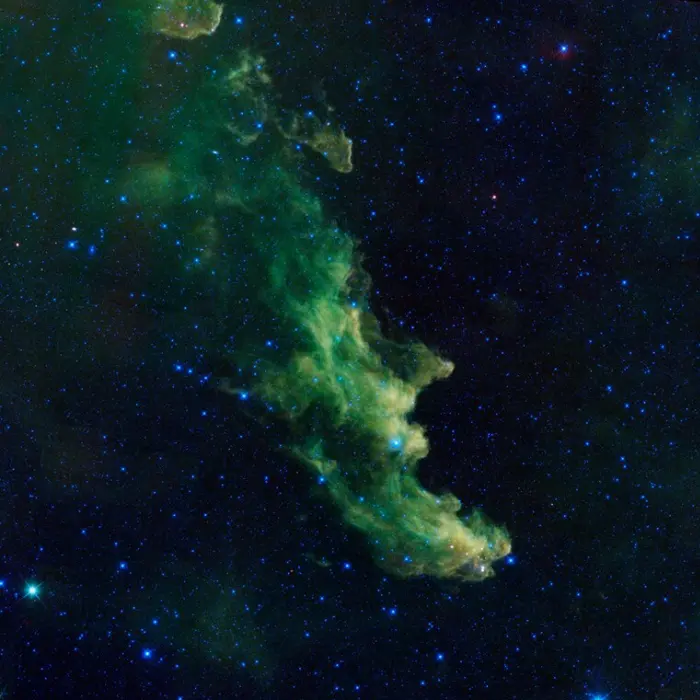
A witch appears to be screaming out into space in this image from NASA’s Wide-Field Infrared Survey Explorer, or WISE. The infrared portrait shows the Witch Head nebula, named after its resemblance to the profile of a wicked witch. Astronomers say the billowy clouds of the nebula, where baby stars are brewing, are being lit up by massive stars. Dust in the cloud is being hit with starlight, causing it to glow with infrared light, which was picked up by WISE’s detectors. Image credit: NASA/JPL-Caltech